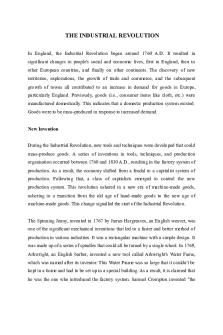Communism during the industrial revolution PDF

| Title | Communism during the industrial revolution |
|---|---|
| Course | Political science |
| Institution | Silliman University |
| Pages | 3 |
| File Size | 104.5 KB |
| File Type | |
| Total Downloads | 14 |
| Total Views | 145 |
Summary
Communism, communism during the industrial revolution, the banding conference,...
Description
COMMUNISM to get rid of social classes and make everything fair for everyone Beginning of Communism during the Industrial Revolution
1940 to 1979: Communism is established by force or otherwise in Estonia, Latvia, Lithuania, Yugoslavia, Poland, North Korea, Albania, Bulgaria, Romania, Czechoslovakia, East Germany, Hungary, China, Tibet, North Vietnam, Guinea, Cuba, Yemen, Kenya, Sudan, Congo, Burma, Angola, Benin, Cape Verde, Laos, Kampuchea, Madagascar, Mozambique, South Vietnam, Somalia, Seychelles, Afghanistan, Grenada, Nicaragua and others.
COMMUNISM DURING INDUSTRIAL REVOLUTION:
Creation of labor forces and factory manufacturing, social changes paved the way for ideas like communism Reason: during the industrial revolution the govt had control of the economy, ex: farmers had no rights over there land bcos the govt had all control over lands, karl marx encouraged the lower class to riot and overthrow the upper class in order to free them from poverty. Karl marx saw the industrial process as the progression of feudal economic, w/c he saw necessary to development of socialism and later communism communism grew out of the socialist movement in 19th-century Europe. As the Industrial Revolution advanced, socialist critics blamed capitalism for the misery of the proletariat—a new class of urban factory workers who labored under often-hazardous conditions.
DURING COLD WAR
Harry S. Truman was against communism GOAL: To support countries in Europe and to stop the spread of communism The USSR successfully planted communist governments in European and Asian Countries
Goals: expand communism through countries
BANDUNG CONFERENCE
At that time, President of Indonesia Soekarno asked Prime Minister of Indonesia, Ali Sastroamidjojo, to deliberate the idea holding of the Asian-African Conference during the Colombo Conference. He stated that the idea had been considered for 30 years and had been sounded in order to build the Asian African solidarity and it was proved through national movement against colonialism.
For the preparation, the Government of Indonesia held a meeting attended by the Indonesian Representative in Asia, Africa, and Pacific. It took place at Wisma Tugu, Puncak, West Java on 9 – 22 March 1954 to discuss the idea that would be brought by Prime Minister Ali Sastroamidjojo to the Colombo Conference, as the basic consideration of Indonesia in widening the cooperation of Asian African region. On 28 April – 2 May 1954, the Colombo Conference was held. It discussed the problems that became Common Conference. At the conference, Prime Minister of Indonesia proposed to hold another similar conference, which was wider in scope for Asian and African Countries. The idea was supported by the whole members of the conference though some were still hesitated. The conference gave Indonesia a chance to explore the possibility of holding it and it was written in the last paragraph of the Final Communiqué of the Colombo Conference. NON ALIGNMENT
Not to align to any of the power blocks- USA & SOVIET Opposing to any kind of alliances like NATO, SEATO, Warsaw Pact Freedom to take its independent decisions Not to remain aloof from intl problems and politics
FACTORS: 1. 2.
After the end of world war II, the world was divided into two power blocks: USA & Soviet Global tension Newly independent Asian-African countries thought that this division wasn’t their interest Non aligning them to any of power bloc would keep the two blocks away from war Hhh Wanted to enjoy their newly acquired freedom and didn’t want any pressure from bigger nations 3. Bb New independent asian-african countries wanted to create their own identity Wanted to solve their own problems w/o any outside interference of influence Wanted to enjoy their right to take independent judgment 4. Cc Newly independent afro-asian countries wanted to spread goodwill and cooperation among all nations of asia and Africa Wanted to establish friendly relations with all nation in order to grow together 5. Dd Were economically backward and had a low standard of living They needed capital and technical know-how to boost their economic development, and they wanted to take benefit from both the power blocs w/o getting any strings attached
6. Ee Realized that although they don’t have military and economic power to influence intl affairs, they had the moral and collective force to maintain and promote world peace...
Similar Free PDFs

THE Industrial Revolution
- 4 Pages

The third industrial revolution
- 2 Pages

Industrial Revolution
- 2 Pages

Industrial Revolution
- 19 Pages

Industrial Revolution in Canada
- 5 Pages

Industrial Revolution Essay
- 9 Pages

Industrial Revolution DBQ
- 8 Pages

Video-CC-Industrial Revolution
- 2 Pages
Popular Institutions
- Tinajero National High School - Annex
- Politeknik Caltex Riau
- Yokohama City University
- SGT University
- University of Al-Qadisiyah
- Divine Word College of Vigan
- Techniek College Rotterdam
- Universidade de Santiago
- Universiti Teknologi MARA Cawangan Johor Kampus Pasir Gudang
- Poltekkes Kemenkes Yogyakarta
- Baguio City National High School
- Colegio san marcos
- preparatoria uno
- Centro de Bachillerato Tecnológico Industrial y de Servicios No. 107
- Dalian Maritime University
- Quang Trung Secondary School
- Colegio Tecnológico en Informática
- Corporación Regional de Educación Superior
- Grupo CEDVA
- Dar Al Uloom University
- Centro de Estudios Preuniversitarios de la Universidad Nacional de Ingeniería
- 上智大学
- Aakash International School, Nuna Majara
- San Felipe Neri Catholic School
- Kang Chiao International School - New Taipei City
- Misamis Occidental National High School
- Institución Educativa Escuela Normal Juan Ladrilleros
- Kolehiyo ng Pantukan
- Batanes State College
- Instituto Continental
- Sekolah Menengah Kejuruan Kesehatan Kaltara (Tarakan)
- Colegio de La Inmaculada Concepcion - Cebu







